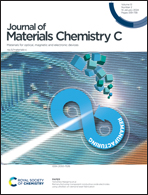Design of Cr–Ba-doped γ-Ga2O3 persistent luminescence nanoparticles for ratiometric temperature sensing and encryption information transfer†
Abstract
Herein, we designed and prepared the persistent luminescence nanoparticles (PLNPs) of γ-Ga2O3:Cr,Ba rationally with Cr ions to achieve the near-infrared (NIR) emission at 700 nm and Ba ions to improve the emission intensity by inducing trap distribution. Energy transfer between γ-Ga2O3 and Cr ions occurs as the emission at 508 nm decreases and that at 700 nm increases along with the increased content of Cr ions. In combination with the trap depth, band gap of the host, and energy levels of Cr ions, an emission mechanism was proposed. Thus, NIR emission (700 nm), high brightness, large Stokes shift (446 nm), and long afterglow time (90 min) were achieved with the optimal γ-Ga2O3:0.0025Cr,0.0012Ba (γGCB) under excitation at 254 nm. The emission intensity of γGCB is temperature-dependent for non-contact ratiometric temperature sensing, and temperature linearity ranging from 300 to 420 K was achieved with an absolute sensitivity of 3.4% K−1. γGCB and γ-G2O3 are white under sunlight but exhibit red and green emissions under single excitation at 254 nm. Thus, Morse and binary codes are adapted to achieve encryption information transfer with the combination of γGCB and γ-G2O3. This work provides ideas for selecting a host, emission center, and trap for PLNPs with desirable properties and thus achieves extensive applications, as validated with ratiometric temperature sensing and encryption information transfer.



 Please wait while we load your content...
Please wait while we load your content...